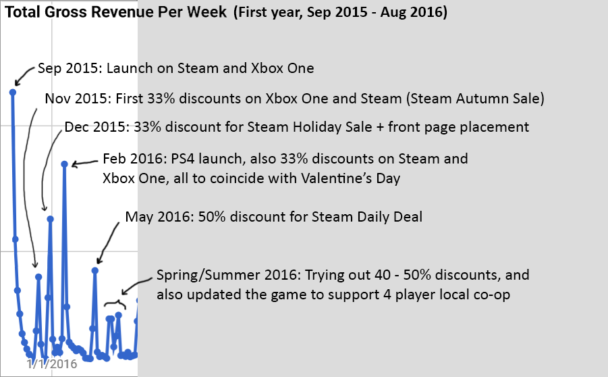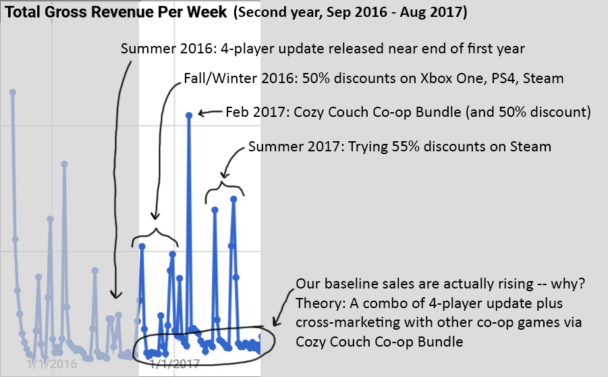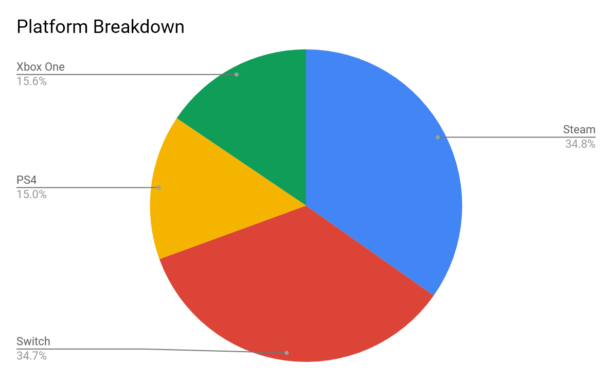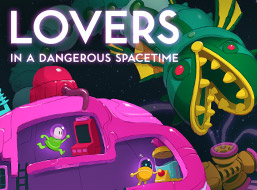It’s hard to believe but this week marks five years since the release of Lovers in a Dangerous Spacetime. We’re extremely grateful for all the players who have given our weird game a chance. None of this would have been possible without your support, so from the bottom of our hearts, THANK YOU.
Now that we have some perspective on selling a video game over the course of five years, we wanted to share some data, because our sales graph didn’t take the shape we expected, and we thought it might be of interest to other developers.
TL;DR: Lovers had an okay-but-not-great launch, and we expected the game would fizzle out fairly quickly, but in fact sales ended up increasing for a few years, and it ended up being quite successful, thanks in part to updates, ports, discounts, word-of-mouth, and of course luck (don’t want to pretend that there isn’t a TON of random chance affecting how games fare).
Launch and Year 1
We launched the original 2-player version of Lovers on Steam and Xbox One on September 9, 2015. It’s a niche game in that it features local co-op, not online. We knew that would limit its sales, but we didn’t know by how much. There were a few other local multiplayer indie games getting buzz back then, like TowerFall, so we figured there could be a market for it. But we had no way to gauge it.
Here’s the shape of our first year of revenue:

Our biggest spike was our launch. We hired a PR company to help us get blog and review coverage, which more or less worked, but our second week of sales declined by half and it continued to drop from there. We ran some 33% discounts after only a couple months to take advantage of Steam’s Autumn and Winter sales (plus we were extremely fortunate to get some front page rotation in Winter) and we got some brief boosts, but then quickly returned to baseline. It was disappointing, but not really surprising.
In February 2016 we launched on PS4 around Valentine’s day, coinciding with discounts on the other platforms and a marketing effort (meaning we re-hired that PR company to push out a press release, and also did an old-fashioned twitter GIF storm). But again, sales fell back to baseline afterwards — although having an extra platform in the mix kept our total baseline sales from declining further.
Year 2: Party games, word-of-mouth, and a bundle
After year 1, we expected our best days were behind us and our future sales would follow the same gradual decline. But surprisingly, our sales stopped declining, and even increased somewhat. Why?

This graph is an example of the stegosaurus tail sales curve, where a game’s long tail, instead of just sloping downwards, is covered in spikes. So what made the difference? Let’s dive in.
One unquantifiable factor is that in May 2016, eight months after launch, we finally added support for 4-player co-op (still local only). There was no huge spike at the time, but from then on, we noticed the game got covered more often as a party game, and if you do a random Twitter search for the game it’s probably still the most frequent discussion context (usually it’s “OMG I love Overcooked, what other co-op games are there?”).
When we noticed this, it gave us the idea to make a Steam bundle featuring us and some other local co-op party games. We approached Steam and the other developers, and everyone was on board, so for Valentine’s Day 2017 we launched the Cozy Couch Co-Op Bundle alongside Overcooked, BattleBlock Theater, Moon Hunters, and Keep Talking and Nobody Explodes. Steam gave us great placement, and the resulting spike was almost as good as our launch. It also had the added bonus of boosting our baseline sales afterwards, as players looking for co-op games could see all our games on each other’s Steam pages.
Throughout our second year we also slowly increased our discount percentage during sales. We kept track of our average daily revenue for each sale, and if it started declining significantly we’d increase the discount percentage. By the end of our second year we were doing 55% off.
And just a note — even though all those spikes make it look like we were constantly on sale, since each platform has their own sales schedule there was actually a lot of time we were just sitting in the stores at full price. Plus there were times when we couldn’t get platforms to include us in sales, or give us store placement, leading to little mini spikes where we’d be on sale but not actually have a large revenue bump.
Years 3 to 5: Switch time
We would never have expected we’d have our highest sales in our 3rd year of release, but hey, thanks Nintendo!

We launched on Switch on October 3, 2017, seven months after the console was released. That launch remains our highest sales spike, and the Switch has been our best-selling platform. In a way it was the ideal platform — the audience is open to colorful, approachable games, 2D gameplay, and the base console even came with two controllers! Plus we pushed hard to release in the first year of the console, meaning the storefront was less crowded. It also meant that we got there in time for the Switch’s first holiday season, which ended up being our second highest spike… until two weeks later, when we ran a 33% off sale in the first week of January 2018 to reach all the brand new Switch owners. Then that became our second highest spike.
There’s not a ton more to note in our sales history, just a lot of running our own discounts on all the platforms, and saying yes to any themed discounts that the account managers at the platforms tell us about, plus we kept doing our own sales around Valentine’s day. We have been nudging down our discount percent over time, and we found a sweet spot at 60% off. We tried 67%, to get us under the $5 price point, but for some reason it wasn’t as successful, so we went back to 60%. Occasionally the platforms will ask us to go lower, but for now we’ve been pushing back since this seems to be a good price.
One interesting thing (and really it’s only interesting for local co-op games) was that in Nov 2019 Steam launched its Remote Play Together service. This service lets people play local-only multiplayer games together online via streaming. Lovers is a perfect candidate to benefit from that, and it even got some placement in the service launch promo. Afterwards, we noticed our baseline Steam sales stopped their slow decline and reversed upwards again, although it’s hard to know exactly how much difference it made because there was also the usual noisy year-end sales bumpiness. It doesn’t seem huge, but we didn’t have to do anything for it — just a lucky break. Thanks Valve!
And finally, there was the surreal Covid sales bump in spring of this year, when widespread lockdowns meant people were stuck at home playing video games. Sales went back to normal fairly quickly, though.
And that brings us up to date.
Overall platform sales breakdown
Steam and Switch have been our main breadwinners (even though Switch launched two years later), but Xbox One and PS4 have been solid performers too. Being on all the platforms has been hugely significant.

Final takeaways
Here’s what we believe helped us avoid the immediate sales decay we’d been expecting:
• Support! Even though our initial launch was disappointing, we found it was super valuable to keep supporting the game with patches, updates, and translations.
• Porting! Despite the long delay between our different launches, it didn’t seem to hurt our arrival on subsequent platforms (especially if you can launch early in a console’s lifecycle).
• Teaming up with other games in similar genres! In our case, the Cozy Couch Co-op Bundle was wonderful for building awareness. It wasn’t just a random bundle — it came from seeing what our audience was talking about and looking for.
• Run discounts! Run all the discounts! It’s also useful to keep track of daily revenue during discounts to inform what percentage to choose for the next discount.
• Luck! Always remember to have luck. Good luck!
And finally, let us say one more time: THANKS FOR PLAYING.











